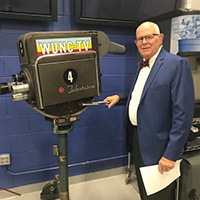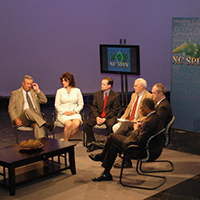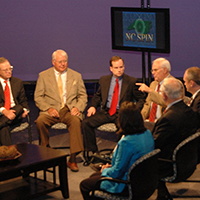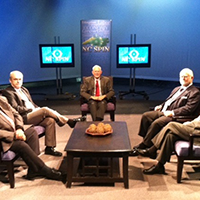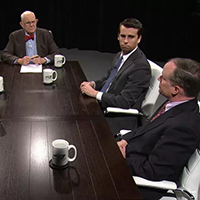For some state retirees, a big pension - and then some more
Published January 4, 2015
by Dan Kane and David Raynor, News and Observer, January 3, 2014.
Some of the state’s highest-paid government retirees are benefiting from a supplemental fund set up by state lawmakers in 2013 so the retirees can receive pensions that otherwise would be too high under federal law.
The pensions of 17 public retirees in North Carolina exceed the federal limits in 2014, in many cases by tens of thousands of dollars. The state’s top-paid retiree, former UNC Athletic Director Dick Baddour, received just over $64,000 of his $281,000 annual pension from the fund.
Other beneficiaries include former Wake County Manager David Cooke, who retired in 2013, and former Durham Schools Superintendent Carl Harris, who left in 2009 to join President Barack Obama’s administration.
In all cases, the retirees and their former employers met their obligations under state law by paying required contributions into the system during the retirees’ working years.
The supplemental fund, known as a qualified excess benefits arrangement, or QEBA, was created by state lawmakers last year to get around a potential problem the state could have fixed nearly 30 years ago, when Congress lowered the pension limits. But back then, no state or local employees in North Carolina were making the kind of money that would bring the limits into play.
“They probably looked and said, ‘It’s never going to apply to anyone,’ ” said Sam Watts, a policy development analyst for the State Retirement Systems Division, which is under State Treasurer Janet Cowell.
Retirement system officials realized about three years ago that some retirees were exceeding the federal limits, which are based on factors such as years of service and retirement age. The limits are typically adjusted upward annually. An employee who retired in 2014 at age 65, for example, was limited to a pension of no more than $210,000. Those who retire at a younger age have a lower pension limit.
Congress gave public pension systems the opportunity to make arrangements for excess retirement benefits in 1996, as those systems began finding some of their retiring employees bumping up against the pension limits. In 2013, officials with the state retirement system asked the legislature to set up a similar supplemental fund.
Lawmakers went along with the request, but they threw in a catch. Access to the supplemental pension money ended Dec. 31, 2014. Those who had not retired by then could find themselves receiving a reduced benefit in line with federal limits.
Schorr Johnson, a spokesman for the state treasurer, said the contributions from high-paid employees and employers typically are enough to cover their pensions. But the amount of pension that is above the federal limit has to come from a separate fund, so the retirement system stays in compliance with federal law. Public pension systems not compliant with federal law could lose their tax-exempt status.
The sunset provision in the 2013 law may have prompted a few public employees to retire before the end of 2014, retirement system officials said. That’s out of a group of roughly 40 people who retirement officials estimated could have been affected by the limits.
State Sen. Tom Apodaca, a Hendersonville Republican and co-chairman of the Senate committee on pensions and retirement, said he wanted a sunset to make sure the state retirement system isn’t on the hook for paying what could be a growing number of pensions that exceed the federal limit in future years. “I just don’t like carving out exceptions for one small group, and we’re responsible for the health of the state retirement plan,” Apodaca said.
A hastened retirement
Roughly 900,000 state and local employees in the state retirement system contribute 6 percent of their salaries each year, while their employers contribute 7 to 9 percent of the employee salaries. Beyond that, the fund relies on investment returns and occasional supplemental appropriations from the General Assembly to keep pensions properly funded for 240,000 retirees.
Employees are guaranteed a specific annual benefit based on their earnings and years of service. Typically, those who retire with 30 years of service receive a pension that amounts to roughly 55 percent of their annual pay. The state has one of the most solvent retirement funds in the nation, valued at $90 billion.
The legislature’s special retirement fund boosts that benefit for those who exceed the federal limits. It is funded by a deduction from the contributions of all public employers into the system. Those deductions are limited to no more than one hundredth of 1 percent of the employer’s contribution into the system. In 2014, the fund paid out roughly $480,000.
The fund was relatively unknown until another highly paid official suddenly announced his retirement.
In October, Raleigh Housing Authority Director Steve Beam provided a cryptic explanation for his decision to retire by the end 2014: If he didn’t get out by then, his pension would suffer. Neither Beam nor the authority’s board would provide a detailed explanation, other than to cite a recent change in state law.
It’s unclear how much Beam, 56, would have lost if his state pension exceeded the federal limit, and it’s unclear how much he will receive. Under the state’s basic pension formula, Beam stands to earn a pension of roughly $135,000 a year.
Beam’s pay was featured in a News & Observer series in 2013. “Checks Without Balances”reported on big salaries paid to some officials for public agencies that often draw little public attention. Beam’s pay put him among the 30 highest-paid public housing authority directors in the country, according to a 2011 federal survey. He made more than housing directors in Chicago, Boston and Charlotte, which all have bigger budgets and staffs.
Beam could not be reached for an interview. He and the housing authority’s board chairman had previously said that his pay reflected excellent service to the authority.
Another former official featured in the 2013 N&O series, Eric McKeithan, appears on the new list of retirees being paid out of the fund. He was the president of Cape Fear Community College in Wilmington who retired in 2012.
In the two years before McKeithan retired, his pay shot up nearly $100,000 – from $237,771 to $334,427 – because the college’s board converted perks such as car and housing allowances into salary. Those perks had not been eligible for pension purposes until they became salary money. They had the potential to spike his pension by nearly $27,000 a year.
Treasurer’s records show McKeithan collected a $172,000 pension in 2014, with $39,000 coming from the special fund.
McKeithan could not be reached for comment. In a previous interview, he said he earned the pension he is receiving.
The General Assembly passed legislation in 2014 to curb pension spiking by tying pensions to total contributions to the pension system, instead of relying solely on a formula that relies on an employee’s four highest consecutive years of pay.
Also on the list of special fund recipients: Billy Williams, the former administrator of the New Hanover County ABC Board. Williams retired in 2010 after the Star-News of Wilmington reported his pay was nearing $280,000 a year, well above any other ABC administrator in the state.
He was later convicted of a felony for using public money to help pay for a new garage at his home. Roughly $19,000 of his $195,000 pension comes from the special fund.
Baddour’s bonuses help
Baddour, UNC’s former athletic director, announced in July 2011 that he would retire earlier than he had planned, after a scandal erupted involving agents plying football players with perks and a former tutor providing improper academic help. UNC fired football coach Butch Davis at that time, and Baddour said he was stepping down early so a new athletic director could pick a new coach.
Since then, the N&O’s reporting helped reveal a bigger scandal of no-show classes with high grades that were primarily designed to help keep athletes eligible. Those fake classes began in 1993 under Baddour’s predecessor, John Swofford, who became ACC commissioner in 1997. Swofford and Baddour have both said they did not know the classes lacked instruction.
As athletic director, Baddour was paid a base annual salary that in his final years reached $295,000. But he earned tens of thousands of dollars more in bonuses tied to postseason play and academic performance. Treasurer’s records show his total annual pay over the last four years of his career averaged $437,000.
Not all of that bonus money would have counted for pension purposes. Federal law also limits how much pay can be subject to pension contributions. In 2014, for example, it was $385,000 for those who became members of a public pension plan by the end of 1993.
In interviews, Baddour said he was not aware of an issue with the size of his pension until several months ago, when he received a call from a state retirement system staff member. Baddour said he was told that some of his pension would be coming out of a separate fund. He was also assured he had nothing to worry about.
Baddour said there should not be a concern regarding his pension because he is only receiving what the state set up for all employees when he began working for UNC 47 years ago. “I’m glad I’m in the plan,” said Baddour, who became a UNC employee in 1967. “I think it’s a terrific plan, and I appreciate the plan, but I didn’t have a choice. ... They took it out of my monthly paycheck, and there was a contract, so I would expect the state to do what it’s done.”
Baddour said he earned the bonuses that boosted his pension.
“I believe the bonuses that I was paid, they were earned,” Baddour said. “They were earned on the field and they were earned ... in the classrooms. And I believe that the administration was helpful to the success of students, certainly through student support, through the academic support program, through the Carolina Leadership Academy and the student-athlete development programs that we have.”
Law is complex
When Congress began placing limits on pension plans in the 1970s and 1980s, it was more concerned with private companies, experts say. The fear was the companies would try to shield business income that would normally be taxed each year as salary by slipping it into a pension fund.
But the federal limits also included public plans that pay no corporate income tax. The limits became a problem for public pension plans in subsequent years as the pay for some positions increased.
“Now, we have some pretty highly compensated state employees – chief medical officers, coaches, heads of human services departments,” said David McKinney, an Oklahoma lawyer who specializes in pension matters.
The federal limit on pensions is set at $210,000 for employees who retired at the ages of 62 through 65. The limit can be less for those who retire at a younger age, designate an additional beneficiary or have fewer years of government service.
“I can’t stress enough the complexity of this thing,” said Steve Toole, state retirement systems division director.
Retirement systems correspondence requested by The N&O showed at least two governmental entities are concerned about losing access to the supplemental pension fund – the state’s public universities and school districts.
The universities employ more highly paid workers than any other public entity. They include hospital directors, top researchers and Division I athletic officials. Larger school districts, meanwhile, are often paying six-figure contracts for superintendents.
Tom Shanahan, general counsel for the UNC system, wants to continue the supplemental fund.
“We don’t think there are a lot of employees who are impacted by this; we think it’s very small,” Shanahan said. “However, the folks we think who would be impacted are medical faculty, long-serving researchers. They are very important to the operations of the universities, health care systems and medical schools.”
He said just extending the supplemental fund for a few years more might take care of the problem. That’s because as retirees age, the IRS pension ceiling goes higher, potentially bringing more of them below the limit, and the IRS continues to raise the ceiling. This year, for example, it climbed from $205,000 to $210,000.
An N&O review of 2013 pay data from the state treasurer’s office shows roughly a dozen veteran university employees who could be over the limit when they retire, because their salaries and other compensation are more than $350,000 a year.
The special funds set up to get around federal pension limits are fairly common. A Google search turned them up in South Carolina, Ohio, New Mexico, Kansas, Tennessee, Colorado and California.
Jane Pinsky, who scrutinizes the workings of government as director of the N.C. Coalition for Lobbying and Governmental Reform, said she had not been aware that North Carolina set up such a fund, and she had not known which retirees were its beneficiaries.
“We all need to know what is going on in our government to make it successful,” Pinsky said.
Jeannine Markoe Raymond, the director of federal relations for the National Association of State Retirement Administrators, said she does not know of any governing body other than North Carolina that placed a sunset provision on its supplemental fund.
Apodaca, the state senator from Hendersonville, sees a fairness issue for everyone else in the retirement system. He said if the universities and other public entities want to exceed the federal limits for highly-paid retirees in the future, they should set up supplemental retirement plans that they fund entirely, instead of using the entire system.
“They’ve got to find another way to fund a benefit for those they hire,” Apodaca said.
STAFF WRITER ANDREW KENNEY CONTRIBUTED TO THIS REPORT.
